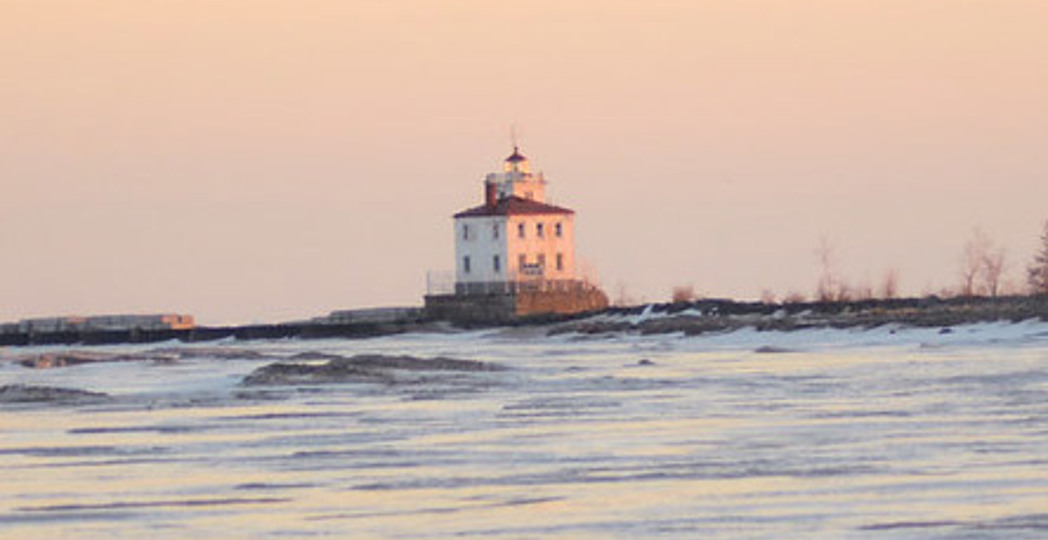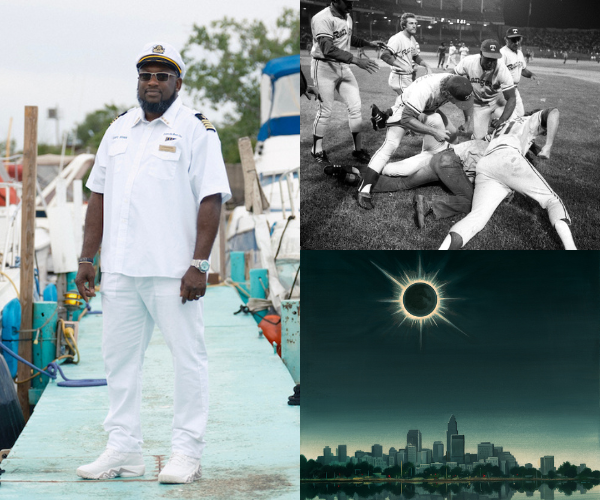When The Lake Freezes
by Dave Lucas | Jan. 23, 2020 | 5:00 PM

Erik Drost
Then, on one of those February days when the sky is the color of limestone, I drive north to Mentor, where I grew up, to see the ice. Past the marsh — set aflame every few years by a fresh set of teenagers — past the mounds of sand, gravel and dyed-blue halite, and toward Headlands Beach State Park.
I look out at ramparts of hardened waves, the lighthouse encased in a sheet of glass. And because water freezes from the top down, I think of what I cannot see: the perch and walleye swimming beneath the surface skein of cold.
When the lake freezes, usually in mid-January, if the winter is cold enough, it starts from the coasts inward. Even in time-lapse photography, the first edges of the freeze are almost imperceptible, the way rest slips into sleep. The slosh, slosh of freshwater laps and then stops. And the ice spreads north, like the fronds that unfurl on frost-crazed windows, to meet the ice sliding south from Ontario.
It’s no coincidence that winter was my father’s favorite time to come to the beach, too. A teacher of geography and history, he relished the sense of human brevity before the deep time of nature.
He understood how saying the words that purport to explain what we observe — phase transition, crystallization, nucleation — could solidify our sense of what we know without dissolving the mystery of what we can’t.
In the winter, the beach was all ours. So we would take the long way home, and stop at Headlands Beach State Park, and look. Or we would turn up our collars and walk against the hard wind so he could show me the striations scored into the bedrock 10,000 or 15,000 years ago.
If I wasn’t astonished then, I am now. The lake, the sand and stones, and my father himself all seemed to me immutable.
Beneath our feet, of course, the earth was shifting. Fish kept swimming beneath the ice. The world went on. Whenever I write about our landscape now, our glacial lakes and ground moraines, I find myself writing about him. Geology, geography, history — all blend into autobiography.
And astronomy, for that matter. The first time I can remember looking out at this frozen lake, I was five years old. In the winter of 1986, my father woke me in the middle of the night, coaxed me into my boots and coat, packed up our amateur telescope in the hatch of his VW Rabbit and drove us to the lakeshore to look for Halley’s Comet. We were after something older even than this place, something mercurial, there just beyond the limits of our vision.
We never saw the comet. Clouds. Light pollution. The sun itself between the comet and the earth. Astronomers say that the 1986 apparition was the dimmest in two thousand years: a stroke of bad luck in the midst of our good timing.
I was five, so the disappointment was both profound and soon forgotten. I secretly hoped that, 75 or 76 years later, I might have another chance. I understood, if only vaguely, that my father would not.
I wrote a poem about this once, before my father got sick. I anticipated the comet returning in the year I would turn 81. In the poem, I imagined being too stubborn to look for it again, having been jilted once. I imagined having buried my father.
I know now I’m too much like him not to go looking again. When something extraordinary happens, you don’t turn away, whether it’s every few years or every 75. Maybe that’s why I end up here every winter, awestruck before a field of white.
The frozen lake always returns me to the flux of my own life. The slap of cold is my madeleine, ushering me back into an untouchable past: here I picked over smoothed stones with my father. Over here, a walk with a first love, a tentative kiss before the ranger warned us away from the ice. And here, before one winter’s freeze, I let my father’s ashes spread into the water’s stinging cold.
What happens to us never stops happening. We live what happens just once out in the world, but for the rest of our lives within us. What disappears returns, if only in the peripheral glimpse of a dream.
Every three years the water in Lake Erie is replenished from rain, from rivers, from the upper lakes. The silt settles to the bottom or washes up on the shore. A comet is composed of ice and cosmic dust. What we see as a trail of fire streaking across the sky is nothing more than stray bits of dirty snow and a cloud of smoke.
These facts help me think, but the mystery remains, deep and fluid. I prefer it that way. I still come here in the cold. I button my coat, walk toward the ice and look for something I can’t quite see.
Trending
-
1
-
2
-
3
-
4
-
5










